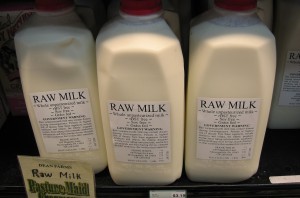Mar 10 2016
A Raw Milk Fiasco
 Legislators in West Virginia passed a law legalizing the drinking of raw milk (but not the sale or distribution). Some of them drank raw milk to celebrate, and later came down sick with stomach symptoms.
Legislators in West Virginia passed a law legalizing the drinking of raw milk (but not the sale or distribution). Some of them drank raw milk to celebrate, and later came down sick with stomach symptoms.
This is one of those perfectly ironic stories that the internet loves. However, the lawmakers in question are denying that the milk is to blame. Instead they blame a stomach virus that has been going around their capital. A definitive answer is not yet available.
While the story is funny, it is irrelevant to the real question – is raw milk safe, and are there any health benefits beyond pasteurized milk? The answer to both questions is no.
Risks of Raw Milk
Safety, of course, is relative, but there is no question that drinking raw milk entails greater health risk than drinking pasteurized milk. Milk is an excellent culture medium, meaning that there are pathogenic bacteria, parasites and viruses that can grow well in raw milk. The CDC lists the most common:
bacteria (e.g., Brucella,Campylobacter, Listeria, Mycobacterium bovis (a cause of tuberculosis),Salmonella, Shiga toxin-producing Escherichia coli [e.g., E. coli O157], Shigella, Yersinia), parasites (e.g., Giardia), and viruses (e.g., norovirus).
Pasteurization was developed as a method of killing off any infectious contaminants in milk, and the process works.
Raw milk enthusiasts will often cite anecdotal evidence of people who drank raw milk without illness. This is misleading, as anecdotes often are. Drinking raw milk is not a guarantee of getting sick, it’s just a risk. The probability of getting an infection from raw milk is much higher than pasteurized milk. There are also frequent outbreaks of foodborne illness linked to raw milk, including serious illness and death.
Proponents argue that good farmer practice can reduce this risk, and it can, but not to zero. Keeping cows healthy and clean, keeping equipment sterile, and good practices during milking and storage are all important and they do help. However, even the best practices with a completely healthy cow does not eliminate the risk of contamination.
By far the most effective method of eliminating infectious contaminants is pasteurization.
Raw Milk is Not Healthier
Raw milk advocates are committing the appeal to nature fallacy, with a knee-jerk emotional reaction against “processed” foods. As with any anti-science or unscientific ideological group, they distort and cherry pick the scientific evidence to make their case.
One claim is that heating milk degrades vitamins. This claim can be filed under true but misleading. A systematic review of studies addressing this claim found that some vitamin levels were mildly decreased in pasteurized milk, however, milk is not a significant source of these vitamins in the first place, so the effect on nutrition is negligible.
Another claim is that heating degrades certain milk enzymes. This is also true but irrelevant. We don’t need milk enzymes anyway. We make our own digestive enzymes. Milk enzymes are just another source of protein and it doesn’t matter if they are degraded and not functioning as enzymes – that would happen once they hit our stomach acid anyway.
Moving on from misleading to just making stuff up, some raw milk advocates claim that raw milk prevent asthma, allergies, and even cancer. There is no compelling evidence for any of these claims. Existing studies are small and of poor methodological rigor. There is preliminary evidence for reduced asthma in children growing up on farms, but it is not possible to isolate drinking raw milk as the important factor in this. There are many other factors involved in living on a farm.
Yet another claim is that pasteurization oxidizes the milk fat, which makes it unhealthy. Oxidation can occur in milk, but it has a variety of causes, which include:
- Equipment surfaces improperly cleaned.
- Minerals in the water supply.
- Acid water and copper tubing.
- Use of chlorine sanitizers.
- Stored forages low in vitamin E.
- Feeding high levels of vegetable fats, i.e. soybeans, cottonseeds.
Oxidation can degrade the flavor of dairy products, especially high fat products like butter and ice cream. For this reason there are many steps that can be taken to reduce oxidation, including homogenization of the milk.
Pasteurization actually has a small and complex effect on oxidation. Heating can actually increase antioxidant activity and degrade the oxidizing effect of copper, depending on temperature. At certain temperatures pasteurization can slightly increase oxidation. Overall the effect is insignificant. Further, oxidation is something that is carefully managed in milk production because of the effect on taste.
Finally, raw milk advocates extol the virtues of beneficial bacteria in milk – the probiotic argument. Probiotics are a separate complex topic, but the quick bottom line is that the bacteria in your gut form a complex ecosystem. Getting extra bacteria in your food does not alter that ecosystem. You don’t need, nor do you benefit from bacteria in milk. If, despite the lack of evidence, you want to eat probiotics, then you can buy products that have had specific beneficial bacteria added. You don’t need to take the chance of whatever bacteria happen to be in your raw milk.
Conclusion
Advocating for the consumption of raw milk is an ideological unscientific position. Consuming raw milk entails greater risk without any proven health benefit. You can get all the nutritional benefits from milk by consuming pasteurized milk products.
Arguments put forward for raw milk all involve a significant distortion of the scientific evidence, much like the anti-vaccine movement or any science-denial movement.






